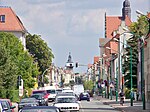Saxony-Anhalt

Saxony-Anhalt (German: Sachsen-Anhalt [ˌzaksn̩ ˈʔanhalt] ; Low German: Sassen-Anholt) is a state of Germany, bordering the states of Brandenburg, Saxony, Thuringia and Lower Saxony. It covers an area of 20,451.7 square kilometres (7,896.4 sq mi) and has a population of 2.17 million inhabitants, making it the 8th-largest state in Germany by area and the 11th-largest by population. Its capital is Magdeburg and its largest city is Halle (Saale). The state of Saxony-Anhalt was formed in July 1945 after World War II, when the Soviet army administration in Allied-occupied Germany formed it from the former Prussian Province of Saxony and the Free State of Anhalt. Saxony-Anhalt became part of the German Democratic Republic in 1949, but was dissolved in 1952 during administrative reforms and its territory was divided into the districts of Halle and Magdeburg. Following German reunification the state of Saxony-Anhalt was re-established in 1990 and became one of the new states of the Federal Republic of Germany. Saxony-Anhalt is renowned for its rich cultural heritage and possesses the highest concentration of UNESCO World Heritage sites in Germany.
Excerpt from the Wikipedia article Saxony-Anhalt (License: CC BY-SA 3.0, Authors, Images).Saxony-Anhalt
K 1295,
Geographical coordinates (GPS) Address Nearby Places Show on map
Geographical coordinates (GPS)
| Latitude | Longitude |
|---|---|
| N 52 ° | E 11.7 ° |
Address
K 1295
39218 , Schönebeck-Salzelmen
Saxony-Anhalt, Germany
Open on Google Maps






